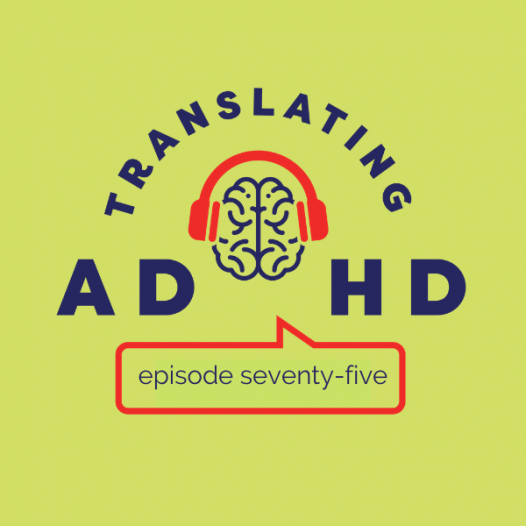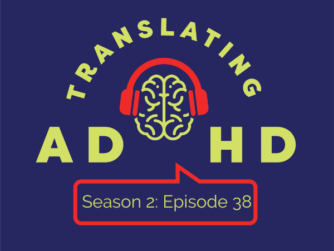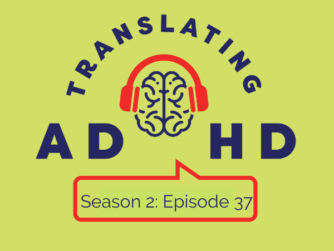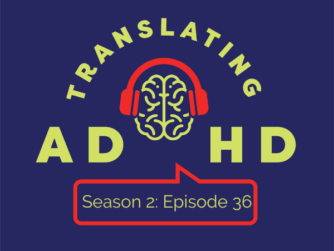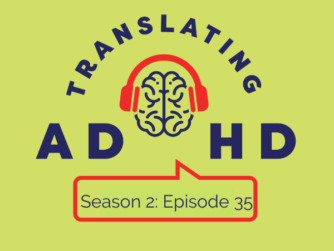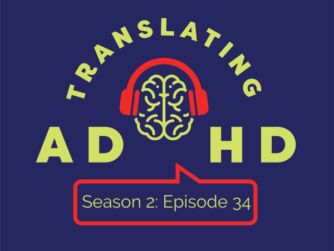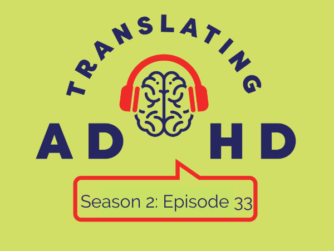As ADHD people, we pay most attention to the the things that generate the biggest signals. This causes us to give our attention to things that may not be our priority, and to avoid the big signals that are painful.
The big signal generators that often get our attention include: interest, urgency, avoidance, emotion, visibility, novelty, and perceived conflict.
This week Cam and Shelly bring the REBEL model together by discussing how we can apply REBEL model to navigate our ADHD brain’s “signal based attention system”. We discuss several successful outcomes with our ADHD coaching clients that demonstrate REBEL in action and how it can help us tune into more subtle signals.
The REBEL model:
Remember to remind the brain
Expand the mind
Balanced Attack
Exposure to time, to new experiences
Limit scope, start with what you know
Episode links + resources:
For more Translating ADHD:
- For episode transcripts visit TranslatingADHD.com and click on the episode.
- Follow us on Twitter: @TranslatingADHD
- Episode Transcription: TranslatingADHD.com
Episode Transcript:
Shelly: [00:00:00] Hi, I’m Shelly. (And I’m Cam.) And this is Translating ADHD. This week, we are going to zoom back out on REBEL and bring the whole thing together. And how we’re going to do that is we’re going to talk about REBEL in the context of navigating signals. So the last couple of episodes Cam mentioned that as ADHD people, we have a signal based attention system, and this is different language than we were using before.
Prior, Cam and I used the phrase interest based attention system. Which tells part of the story, but Cam, what I love about signal based attention system, is it really fleshes out this picture. So after you first brought that phrase up, I sat down and I started thinking about what are the signal generators. By the way, listeners, this is not intended to be a complete list.
Think of this as a starting place for you to think about what are your own signal generators? What are the things for you that generate the loudest or biggest signals?
Cam: [00:01:20] Yeah. So this is big. We’re just unpacking this for the first time. So we’re going to get a lot of mileage out this, but I just want to, when you talk about signal generators, we’re talking about up above the lunch counter.
Last week, we talked about how those of us with ADHD, it’s often we cope by kind of navigating these intense signals, be them positive and negative. We try to avoid the negative things and we’re pulled into the positive. So that interest-based area. What we’re fascinated with, curious about, we dive deep into that versus the stuff that might be too painful.
Too hard to go and look at it. And so we avoid at all costs. So it’s sort of like this. I came up with this idea. It’s like navigating amusement parks and rift zones as my odd place that out there, because again, amusement park is someplace you go. We used to go and have fun and engage and it was positive.
A rift zone is a geologic term, which actually it’s not a big deal, but it sounds ominous. It’s actually where the earth is tearing apart, people. If you go there. It’s actually pretty mild area, but just the idea of a rift zone, it’s like treacherous and torn apart to avoid at all costs. So you can put something else in there, but here we are really kind of holding back.
Our bodies are tense. Trying to navigate through between these rabbit holes of positive and rabbit holes of negative and it’s exhausting.
Shelly: [00:03:00] Yeah , so here is my starting list. The things that I noticed for me and for many of my clients can be things that generate big signals. Interest is one or lack of interest. Sometimes a lack of interest can put us in that avoidance place. Urgency, avoidance emotion, be it strong, positive, or strong, negative emotion and visibility. Sometimes just the thing that is immediately in front of us is the biggest signal. And so listeners, I’m curious. What can you add to this list? If you want to tweet at us or for those of you in the Discord community, if you want to share what might be a signal generator for you, because this is not intended to be a complete list.
This is a starting place. Just what I thought of after Cam first brought this phrase to the show.
Cam: [00:03:59] Right now, I’ll add novelty. Which is sort of a combination of ala carte or mix and match here because novelty, the shiny object, it comes into visibility. It’s new, the newness of it, just that shiny object, the intensity of that.
So add that to it. Novelty, visibility, emotion, positive and negative. A sense of urgency. Interest. Perceived conflict.
Shelly: [00:04:26] Ooh, that’s a good one.
Cam: [00:04:27] That was a big one for me. Coupled with this sort of personality stuff of who we are, who we tend to be of the peacemaker, kind of like, ha you know what? I can put that off until tomorrow.
I love this list though, because what it does, Shelly, is it takes us above the lunch counter. We have this place that these signals are generated. That are fabricated. We talk about the factories above the lunch counter at causation that create these intense positives and intense negatives that we try to navigate down in the valleys below the lunch counter.
Shelly: [00:05:05] Yeah. So what I’d like to do now is I’d like to bring in a client example to walk through REBEL and walk through how this client navigated his signals through the work we did in coaching and is continuing to do that work. So this client obviously has ADHD as all of my clients do. And he came to coaching with a passion project that he hopes to monetize someday.
So right now, his focus is on content creation. He doesn’t yet know how he’s going to monetize this, but he has some ideas based on the field that he previously worked in. So this isn’t new territory for him necessarily. So we ran into several challenges for this client related to how his ADHD brain works.
The first was limiting beliefs. This client is very prone to all or nothing thinking. And when he’s in the nothing thinking he pulls all of this failure context from his past, into the present and uses that to inform the belief that this project will fail. When we did our coaching work around that limiting belief, we discovered that he’s been successful in a number of different ways.
Yes. He’s had setbacks. Yes. He’s had what I would even call failures, but he’s also had many successes. So this is where remember to remind the brain comes in. In fact, this client messaged me over the weekend. We came up with some shorthand. He was just supposed to tell me if he was stuck. And he did, he messaged me and said, I’m stuck.
Guess what: there’s exposure to a new experience. Rather than getting down in that limbic brain and just letting that shut him down for the entire weekend, he reached out to me. There was an opening there. First of all, that in and of itself that reaching out to me and saying I was stuck, was already a new experience.
And there was an opening for him to Remember to Remind the Brain what he knew. So I asked him a couple of questions connected back to what I know about the client, so that he could remind himself of this more realistic picture of who he is, so that he could get away from the nothing thinking and not swing all the way back to the all, but find that healthy place in the middle that is in the center of what he knows about himself.
Cam: [00:08:01] And that right there is Expand the Mind, right. The first E. So a new experience. And capturing and recalling his own card catalogs there, I’ve got a resource I can reach out and share. New experience, new exposure to a different experience. And in doing so, bringing that curiosity, which is a more subtle signal.
It’s a more subtle signal. It’s one of our assets that we bring with us as we navigate these more intense signals, he’s able to, again, Expand the Mind to consider what is possible, because that nothing I love the way you said that, because it’s just articulates what it’s like for us, those of us with ADHD to have just this super intense negative picture of ourself, and the outcome.
It’s like, we’re destined and we have no choice. We have no options. And it’s sort of like this ability to kind of like, wait a sec, pause. Let’s call a time out. I don’t have to go down this path. Just that pause there to consider, to recall a resource, to share. He’s also translating there.
Isn’t he? Right. That’s true. In the sense of our model of understand, own translate. Really, I love this because it just it’s this weaving of all these elements here of REBEL to navigate these strong signals. Hold on a sec. Right. I can pause and consider and saw that he was more resourceful in this moment, more resilient.
Shelly: [00:09:41] Yeah. So let’s talk about another dilemma this client had, and that is how do I monetize this thing? So this client has a limited amount of time in which he can continue to work full time on this passion project without another income coming in. So here again comes the all or nothing thinking, the belief that I can’t work on this project and work a job.
So I have to monetize it, it has to be successful in a very specific way in the next several months. And when he falls into that trap, he gets very outcome focused. We’ve talked a lot about letting go of outcome and that’s in E Expand the Mind because he didn’t start this project to make money off of it.
It’s a passion project that, if he makes money off of it, great. But in talking about it in an Expand the Mind way in looking at journey thinking, he is equally happy. if he learns something from it that he can carry forward to find that next step for him on his journey, that next place he wants to be, that next opportunity.
And so letting go of one specific outcome makes it so much easier for this client to engage in the work before him. And this speaks to Balanced Attack. When he gets stuck in that mindset of, I have to monetize, I have to make money, and I have to do it yesterday. He’s dragging in all of these actions and activities and putting himself in a state of complete overwhelm.
But when we step back and remember that first and foremost, this is a journey and there’s more than one option before us. If monetization doesn’t happen right away, he’s able to remember to balance his attack, and to keep his attention on what matters right now. What is immediately before him. This also speaks to Limit Scope.
Because when we detach from outcome, especially an outcome that is so far away, that we might be limiting ourselves by trying to shoe horn into that one outcome, it becomes easier to limit scope because we can turn our attention to what is immediately ahead of us. Cam, we’ve talked about that before in terms of us and this podcast.
We started translating ADHD with the goal of putting out an episode a week for a year. And while we had these other ideas or other outcomes that we were excited about, that we wanted to jump on, that we hoped would come to fruition someday. We limited our scope to just getting an episode out every week for a year so that we could then see, what are we working with here?
What are we working with here in terms of our platform who’s listening, who’s engaging and what do we do with that information? Because now we have concrete information to take the next step, to know what’s actually possible for us at this time.
Cam: [00:13:06] That’s really great. As you’re talking, I was just thinking about a recent client that I can plug right into this. And last time we spoke, right at the end of our coaching session., I mean, we’re signing off. She’s like, Oh, by the way, I’m managing my emotions more effectively. And I just want to make sure we talk about that. And that got my attention because for ADHD, that’s a huge one, that whole thing around emotional dysregulation.
And so when she said that I circled that I boxed it. I started to make sure we came back to that. So she came this week with a different set of topics. But I was like, Hey, you said something last week that was really relevant. Can we talk about that? Because you’re being successful here. You’re having a different experience.
Exposure. You’re exposing yourself to a different and new experience of experiencing your emotions differently. And she went to go on and talk about how she kind of rides this handbrake through her week. Just holding back, holding back, holding back, and it fits beautifully into this whole idea of navigating amusement parks and rift zones.
Just white-knuckling it through your week, holding back. So you don’t get pulled into a big distraction or get pulled into a big negative place. And she’s realizing though is wanting to release that. She’s starting to develop other methods of control. She said, listen, I’m not going back to that because I just have tension in my body.
Just like literally lifting up on the handbrake in your car and holding it all week, working against herself, but always that kind of fear of, or you release it. It’s too much, too much, too much of that individual. But it was sort of like some Shelly mantras that she came up with.
So she deals with perfectionism. It has to be a certain way. And as she was going out there and sharing her own content with the world, she came up with two mantras that are very much in the line of REBEL. One is: It Doesn’t Matter. She said, what really does matter, but in this moment, it really doesn’t matter. Like, if I mess up. It’s a mess up, like I said last week with it’s a do over. To be able to kind of be present to that moment to let go of outcome.
And that really the most important thing was to show up, to show up and be present. So showing up and being present and coupled with that, it doesn’t matter was: We’ll Figure It Out as We Go Along. And we’ll figure it out as we go along, this is kind of expand the mind. She’s remembered to remind the brain of these two mantras and in a way it’s limit scope too.
We’ll figure it out and kind of like this incremental approach of be here with this experience. And so it’s about presence. It’s about working this process, this opportunity right now, but it’s allowing her to navigate without this constant kind of pull back on the yoke. We’re on the reigns, like holding back, it’s a release, but she’s finding this sort of, these levers to navigate around these strong signals to get to outcomes that push her own agenda forward.
So exposure to new experiences. This balancing attack. There’s that emotional, intense aspect of her, very passionate, but also like, okay, let’s just show up and engage and engage specifically what I’m trying to do here. And then limit scope. That’s a completion and we move on and we learn from it. We take that learning last week, we talked about action learning model, have the action, grab the learning from it, apply it forward.
Really fascinating. Did we deliberately do REBEL there with her? No, but I’m noticing as you’re talking about your client and we’re talking about these signal generators, she was working that. All aspects of that. And then the best part, Shelly, is the experience is such a great teacher. To have that experience and be there and witness that I’m like, wow, that really worked well.
What worked about that to take that forward? And it’s getting her out of her default mode, she’s a big brain presenter like me. And in our thoughts, it was like for her, it was like getting into action so that it doesn’t matter, and we’ll figure it out as we go was very helpful to get her out of that thinking mode into the action.
Then reflect and back to thinking again and planning the next step back to those staircases and moving the melons up the stairs. This is a lot we’re doing here. So if you’re kind of blown away with like, Whoa, we’re doing a lot here. We are. And so back to that, starting with identifying your signals and not to like assign evaluation, this is good, or this is bad. It just is. To get it out there. We’ve always said that what we do and what’s really important for managing ADHD effectively is orienting ourselves to the actual dilemmas.
Part of the whole ADHD experience is not even seeing what we’re up against. So putting this out and kind of determining that list of: what are the things that are intense signals, and starting to locate them and your own behavior around them. Don’t judge like, Oh, I just went into this rift valley, you know, and I was there for a week. That’s terrible. The value of the awareness is huge. And I always like to say, if you’re having new awarenesses, mindfulness and meditation, don’t work for 12% of the population, it’s too intense.
To find someone to go in there with you to navigate, be it a coach, be it a therapist, be it professional. If it’s too overwhelming, don’t do it alone.
Shelly: [00:19:46] Cam, I love that you say, start with the signals. Start where we started at the top of this episode, because as we’ve talked about REBEL, And we’ve tried to put it in an order.
I believe a couple of episodes ago, you suggested LARBE?
Cam: [00:20:05] No, no, not LARBE. LERBE!
Listen, I’ve got it up in front of the committee, Shelly. Right? You didn’t know this, but I’m making a presentation this Wednesday to the big committee on changing REBEL to LERBE.
LERBE, people!. Come on. I see a bumper sticker.
Shelly: [00:20:24] Listen. Here’s my points. I don’t think there’s a right order. I’ve been looking at and considering REBEL and noticing how these elements naturally show up with my clients as part of the coaching process. And the entry point, the letter we dive in and address first, depends entirely on what has my client’s attention and what is standing most in the way.
So for the client that I brought today, Remember to Remind the Brain and Expand the Mind where the two most important things for us to make progress on that opened up progress to every other part of REBEL and every other dilemma that he was having around this big agenda of moving this passion project forward, creating consistency there, and putting out a product that he was proud of.
But that’s not true for every client. My clients are all over the map in terms of where we dig in and start there’s no right order. So when you look at your signals, look at where they’re coming from for you, what are your signal generators? What are you noticing?
You can use REBEL as a way to consider, and what is my entry point here into awareness? Into having a different experience? Into learning something new about my uniquely wired ADHD brain? You can try something on and you may not get it right the first time, you may pick a place to start and discover that that’s not the place at all, but that’s part of picking apart these big dilemmas and putting them into smaller, more manageable pieces. To me, that’s what this model does is it takes these big dilemmas we work on in coaching, and it takes the work that we do in coaching and the work that we encourage our listeners to do using this show and gives it language. But there’s no right order.
It doesn’t have to be REBEL. It doesn’t have to be LERBE. Find an entry point, try it on, have a new experience. Learn something. And do it again.
Cam: [00:22:42] This is important. Mount Rainier work that you identify the signals, you identify your experience with those signals. You’re doing your own Mount Rainier work. You’re doing cause and effect you’re seeing how these impact you and your behaviors as you try to navigate your day. The other thing is we started with this signal list. Of interest, urgency, emotion, visibility, novelty, and conflict. These signal generators. I was making an alternative list that as we work with rebel, do you know what pop for me as we worked with REBEL?
Shelly: [00:23:20] What’s that?
Cam: [00:23:21] Well, we talked about, like ,being more present in process. Having your experience. And then I started writing down these, all these Cs, the Six Cs, the Six Cs are these sort of subtle signals in the sense of being at choice, being curious, creativity. One that we talk about all the time, it’s not a Six C, is context: of getting clear on what matters, how this all connects.
What’s the bigger opportunity? These are subtle nuanced signals that can’t compete with the big guys. They’re just not going to be the biggest rollercoaster. They’re not going to be the biggest pit of despair. Those are just they’re big in their bigness. But when you pause to consider and locate yourself and just kind of be notice, you start to develop these other assets or tools that can generate their own signal and, you know, curiosity lives outside the limbic.
And so it does generate a signal, but it doesn’t generate one as intense as the ones that we shared at the beginning. But when we pause to consider and develop awareness and understanding, then we get a sense of the lay of the land. There is more to it than these super intense guys out there.
Shelly: [00:24:52] Well said, Cam, and I think that’s a great place for us to wrap the episode for today.
If you like what we’re doing here on the show, the number one way you can help us out is to leave a review wherever you listen. You can also support the show financially and join our Discord community of people working together to do their own, understand own translate, work with the support of Cam and I, by visiting, translatingadhd.com, clicking on the Patreon link in the upper right-hand corner.
Also big news! Transcripts for each episode are now available, starting with episode number 74. So if you visit the website and click on the episode, you want the transcripts for, the transcript will be available at the bottom of the page. And over time, we will also be working through our older episodes to provide transcripts for those as well.
Cam: [00:25:46] This is huge. People have been asking about, are there transcripts? I’m not an auditory processor, so this is awesome. I love it.
Ha. So shout out to a client of mine who recommended Descript in order to do transcriptions, because it does it automatically.
And shout out to you. Cause you’re the one that’s taking it on. So shout out to Shelly, she’s making this happen. She’s instigator. Yes, you are.
Shelly: [00:26:12] I am. Thank you for that Cam. I will take that celebration and run with it. So check out the transcripts, check out the site, leave us a review. Join the Patreon become part of the conversation. And until next week I’m Shelly (and I’m Cam) and this was Translating ADHD.
Thanks for listening.

